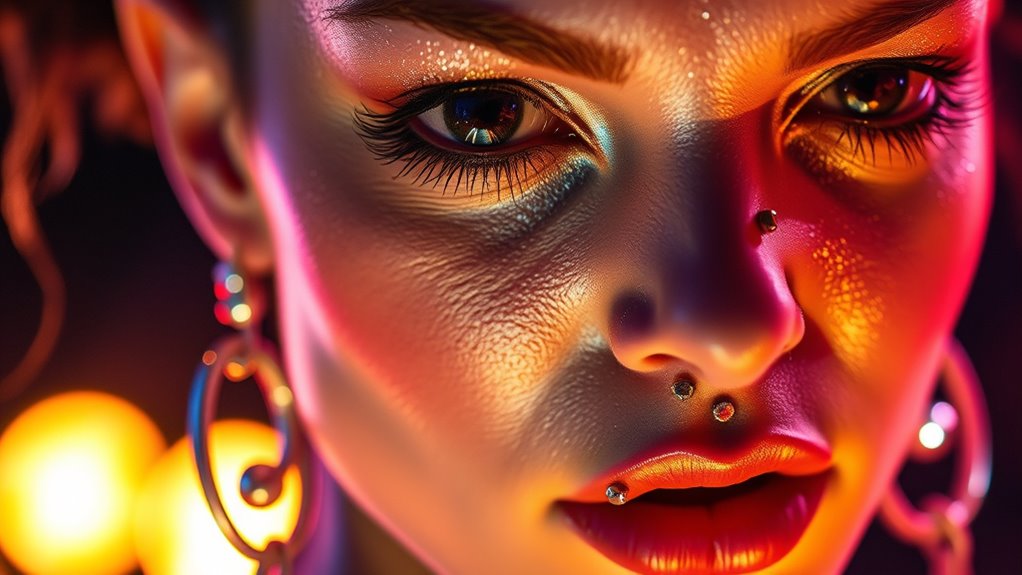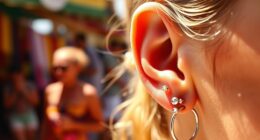Piercings in visual and performance art serve as powerful symbols that convey identity, cultural heritage, resistance, and personal stories. They are more than just decoration; they challenge beauty standards, mark shifts , or express rebellion. Artists use body modifications as performative gestures, making statements about culture or individuality. If you explore further, you’ll discover how these piercing symbols deepen our understanding of human expression and the ways people communicate beyond appearance.
Key Takeaways
- Piercings in visual arts symbolize identity, transformation, rebellion, and cultural heritage, enriching thematic exploration beyond aesthetics.
- In performance art, piercings serve as performative gestures of resistance, control, or cultural commentary.
- Artists incorporate piercings to challenge societal beauty standards and express personal or collective narratives.
- Cultural influences shape the symbolic meaning of piercings, linking them to rites of passage, social status, or spiritual beliefs.
- Piercings deepen the storytelling in art, reflecting complex personal and cultural identities through body modification.

Piercings have long served as powerful symbols and tools in visual and performance art, challenging traditional notions of identity, beauty, and self-expression. Their symbolism in piercings often goes beyond mere decoration, embodying personal stories, social status, or cultural affiliations. When you observe a piercing, you’re witnessing more than an aesthetic choice; you’re seeing a deliberate act loaded with meaning. Different cultures have historically influenced these symbols, shaping how piercings are perceived and utilized. For instance, in some Indigenous communities, facial piercings represent rites of passage, spiritual beliefs, or social hierarchy. These cultural influences inform the way artists incorporate piercings into their work, making them potent visual elements that evoke specific histories or identities.
Piercings symbolize identity, culture, and resistance, shaping visual art and personal stories across diverse traditions and communities.
In visual arts, artists use piercings to explore themes of identity and transformation. You might notice a piece where a subject’s piercings symbolize rebellion or non-conformity, challenging mainstream standards of beauty. Alternatively, they can serve as markers of cultural pride or heritage, connecting the individual to ancestral roots. Performance artists, on the other hand, often incorporate piercings into their acts to provoke reactions or communicate complex messages. For example, a performer might use body modifications as a form of resistance or to question societal norms around body autonomy. The act of piercing itself becomes a performative gesture—an assertion of control over one’s body or a statement against conventional beauty standards. Recognizing the symbolic significance of piercings deepens the understanding of their role beyond aesthetics.
Cultural influences also shape how piercings are perceived within different communities. In some societies, piercings are a rite of passage, signifying transition into adulthood or spiritual awakening. In others, they’re a form of rebellion against cultural or political oppression. Artists often draw inspiration from these diverse backgrounds, blending traditional symbolism with contemporary narratives. This fusion enriches the artistic dialogue, allowing viewers to interpret piercings not just as aesthetic choices but as deeply embedded cultural signifiers. When you encounter such works, you’re invited to contemplate the layered meanings behind each piercing and how cultural histories influence individual self-expression.
Ultimately, the symbolism in piercings reflects a complex interplay of personal meaning and cultural heritage. As you explore visual and performance art that features body modifications, recognize that these adornments are not just decorative but serve as powerful expressions of identity, resistance, and cultural storytelling. They challenge you to look beyond surface appearances and appreciate the rich narratives embedded within each piercing, shaped by centuries of cultural influences and individual choices.
Frequently Asked Questions
How Have Historical Perceptions of Piercings Influenced Their Representation in Art?
Historical perceptions of piercings have shaped their representation in art by reflecting societal perceptions and historical symbolism. You see, once considered rebellious or taboo, piercings now symbolize identity, empowerment, or cultural heritage. Artists incorporate these elements to challenge norms or evoke deeper meaning. This evolution influences how you interpret artworks, recognizing that piercings often carry layers of societal perceptions and historical symbolism that communicate complex messages about identity and cultural shifts.
What Are Some Iconic Artworks That Prominently Feature Piercings?
You see piercing as a symbol of rebellion and body modification, echoing through iconic artworks like Cindy Sherman’s photographs and Jenny Holzer’s installations. These pieces serve as allegories for artistic expression, challenging societal norms and celebrating individuality. Through their vivid imagery, they transform piercings from mere adornments into powerful statements, illustrating how art captures the evolving perception of body modification, making the body a canvas for cultural dialogue and personal identity.
How Do Performance Artists Incorporate Piercings to Challenge Societal Norms?
You can incorporate piercings into your performance art to challenge societal norms by emphasizing body modification as a form of self-expression. Using piercings, you push boundaries around gender expression and identity, making viewers rethink conventional standards. By intentionally displaying or altering your body through piercings, you provoke conversations about acceptance, conformity, and individuality, encouraging others to question societal expectations and embrace diverse forms of personal and gender identity.
What Are the Cultural Significances of Piercings Depicted in Visual Arts?
Piercings in visual arts serve as vivid symbols of cultural symbolism and artistic expression, acting like tattoos etched in history. They tell stories of identity, rebellion, and tradition, transforming the body into a living canvas. When depicted in art, piercings challenge viewers to reconsider societal norms and embrace diverse cultural narratives, making each piece a compelling dialogue between personal history and collective meaning.
How Has the Symbolism of Piercings Evolved in Contemporary Art Forms?
You see that in contemporary art, the symbolism of piercings has shifted toward emphasizing body modification as a form of identity expression. Artists now use piercings to challenge traditional norms, showcase individuality, and explore personal narratives. This evolution reflects a broader acceptance of diverse body modifications, transforming piercings from mere adornment to powerful statements about self-identity and social commentary, making them central to modern artistic dialogues.
Conclusion
You realize that piercings in visual and performance art aren’t just about adornment—they challenge societal norms and express raw vulnerability. By examining these acts, you see how piercing can symbolize rebellion, identity, or transformation. The truth is, piercings become a powerful metaphor for breaking boundaries and embracing authenticity. When you engage with this art, you uncover a deeper message: true freedom lies in embracing your unique self, no matter what others might think.















